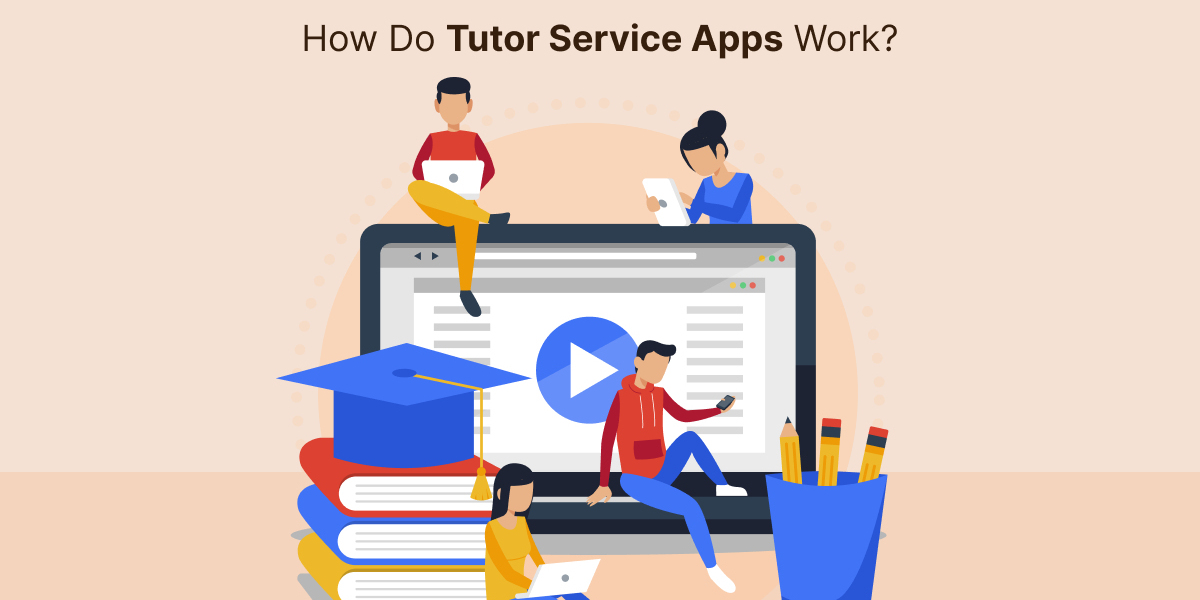Education has evolved significantly over the past few decades, with technology becoming an integral part of how we learn and teach. Among the many technological advancements, tutor service apps have emerged as one of the most transformative tools. These apps provide students with direct access to qualified tutors, breaking down traditional barriers such as location, time, and cost.
But how exactly do these apps work? What are the steps that connect a student to the right tutor? And how are these platforms reshaping the education landscape? This blog dives into the detailed process, features, benefits, and future trends of a tutor service app, making it easy for anyone to understand their impact.
How Tutor Service Apps Work
Registration
The journey begins with registration. Both students and tutors need to sign up on the platform to get started.
- Students: They provide basic details such as their name, age, academic level, and the subject(s) they need help with.
- Tutors: Tutors create detailed profiles that include their qualifications, teaching experience, areas of expertise, and a short bio to introduce themselves to potential students.
Profile Verification
Verification is a critical step to ensure that only genuine users are part of the platform.
- For tutors, this typically involves uploading academic certifications, government-issued IDs, and other credentials. In some cases, background checks are also conducted.
- For students, the process is simpler and usually involves validating their email or phone number.
Searching for a Tutor
Once registered, students can search for tutors that meet their specific needs. This is where the app’s search and filter functionality comes into play.
Students can refine their search based on:
- Subject or topic.
- Availability and time zone.
- Language preference.
- Hourly rates.
- Ratings and reviews from other students.
The search engine ensures that students can quickly find tutors who align with their learning goals and budget.
Booking a Lesson
After finding the right tutor, students can book a lesson. Tutor service apps often provide two main options:
- On-Demand Sessions: These are for immediate learning needs, such as last-minute homework help.
- Scheduled Lessons: Students can pick a date and time for future sessions, allowing for better planning and recurring classes.
Payment Process
To maintain security and convenience, these apps integrate payment gateways for hassle-free transactions.
- Students pay for their sessions upfront.
- The app holds the payment in escrow and releases it to the tutor after the session is completed to ensure student satisfaction.
Conducting the Class
Classes are conducted within the app, using various interactive tools:
- Video calls for face-to-face interaction.
- Digital whiteboards are used to solve problems and share notes.
- Chat features for quick queries.
- File-sharing options for assignments or additional study material.
Some advanced platforms also integrate screen-sharing capabilities and real-time collaborative tools to enhance the learning experience.
Feedback and Reviews
After the session, students can leave feedback and rate their tutors based on their experience. Tutors can also share their thoughts about the student, ensuring accountability on both sides.
Tutor Earnings
Tutors receive their earnings after the session, minus the app’s commission. The earnings are transferred to the tutor’s bank account or e-wallet, depending on the platform.
Features of Tutor Service Apps
User Profiles
Profiles act as the foundation of these platforms.
- Student profiles: Include their academic level, preferred learning styles, and any additional notes for tutors.
- Tutor profiles: Highlight qualifications, subject expertise, teaching methodology, and hourly rates.
Advanced Search and Filters
The app’s search functionality allows students to quickly find tutors that meet their needs. Filters like subject, availability, price range, and ratings ensure a seamless experience.
Scheduling and Notifications
Built-in scheduling tools let students book sessions in advance. Automatic notifications remind both parties of upcoming lessons to reduce no-shows.
Secure Payment Integration
Integrated payment gateways support multiple options, including credit/debit cards, PayPal, and mobile wallets, ensuring quick and secure transactions.
Interactive Learning Tools
Digital whiteboards, video conferencing, and file-sharing features provide a virtual classroom-like experience, making lessons more engaging and effective.
Ratings and Reviews
A transparent feedback system allows students to make informed decisions and helps tutors build credibility.
Performance Tracking
Some apps provide progress reports for students, enabling them to track their improvement over time.
Benefits of Tutor Service Apps
For Students
- Access to Expertise: Students can connect with qualified tutors from around the world, ensuring they find the right match for their learning needs.
- Convenience: No need to travel or stick to rigid schedules—students can learn from the comfort of their homes.
- Personalized Learning: One-on-one sessions allow tutors to tailor lessons to a student’s pace and learning style.
For Tutors
- Global Reach: Tutors can teach students from different parts of the world, expanding their opportunities.
- Flexibility: Tutors can set their working hours and rates, giving them control over their schedules.
- Reliable Payments: The app ensures secure transactions, eliminating the hassle of chasing payments.
For Parents
- Transparency: Parents can monitor their child’s progress through session records and performance reports.
- Safety: Verified tutors and secure payment systems provide peace of mind.
Challenges in Tutor Service App Development
Ensuring Quality
Maintaining a pool of highly qualified tutors is a challenge. Apps need to conduct thorough background checks and performance evaluations.
User Engagement
Retaining users requires constant updates, innovative features, and excellent customer support.
Data Privacy
Since these apps handle sensitive information like payment details and personal data, robust security measures are essential to prevent breaches.
Future Trends in Tutor Service Apps
AI-Powered Personalization
Artificial intelligence can analyze a student’s performance and suggest tutors or learning materials tailored to their needs.
Virtual Reality in Education
Virtual reality can create immersive learning experiences, making subjects like history, science, and geography more engaging.
Gamification
Introducing gamified elements like badges and leaderboards can make learning fun and motivating, especially for younger students.
Multi-Service Platforms
Some tutor apps are evolving into multi-service platforms, offering features like homework help, career counseling, and even mental health support. This mirrors the success of platforms like Gojek, which offer a wide range of services in one app.
Conclusion
Tutor service apps are reshaping the education landscape by making quality learning accessible to everyone. From easy registration and secure payments to interactive tools and personalized teaching, these apps are designed to provide a seamless experience for students and tutors alike.
As the demand for online learning grows, the scope for innovation in this space is immense. Developers can take inspiration from successful platforms and incorporate advanced technologies like AI and VR to enhance user experience.
If you’re considering building an app, looking at multi-functional platforms like an app like Gojek can be a great starting point. By diversifying the services offered, you can cater to a broader audience and create a comprehensive solution that stands out in the market. With the right features and a focus on quality, tutor service apps can potentially transform education on a global scale.









